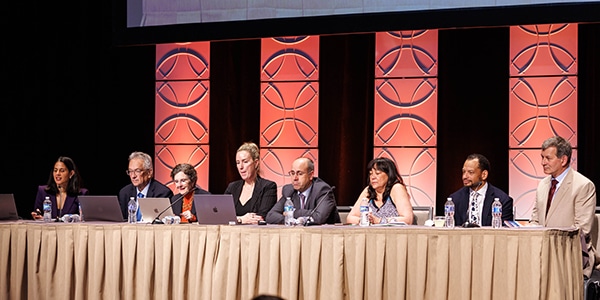SABCS 2023: As Conference Ends, Experts Look to the Future
“What will you do Monday morning?” was the question posed by the final session on the final full day of the 2023 San Antonio Breast Cancer Symposium (SABCS), held Tuesday, December 5 to Saturday, December 9.
After four days of groundbreaking presentations, conference attendees gathered Friday for the traditional “View from the Trenches” session to understand the immediate impact of the findings reported at this year’s SABCS—particularly, how the new data will influence clinical decisions come Monday.
Moderator Sara Tolaney, MD, MPH, of Dana-Farber Cancer Institute, introduced the seven panelists who were tasked with offering their insights:
- William Barlow, PhD, University of Washington
- Javier Cortés Castán, MD, PhD, Ramon y Cajal University Hospital in Madrid
- Lesley Glenn, Project Life
- Heather McArthur, MD, UT Southwestern Medical Center
- Joyce O’Shaughnessy, MD, Baylor University Medical Center
- Richard Zellars, MD, Indiana University School of Medicine
- Alastair Thompson, MD, MBChB, Baylor College of Medicine

The panelists agreed that many of the studies presented this year were practice-changing, while others reinforced existing standards of care. The discussions focused on various clinical contexts, including different breast cancer subtypes, stages, and lines of treatment.
Targeted therapies for HR-positive breast cancers
Tolaney kicked off the discussion with a look at the first-line treatment of metastatic hormone receptor (HR)-positive breast cancers. This year’s SABCS featured results from several phase III clinical trials that evaluated the impact of adding CDK4/6 inhibitors to first-line endocrine therapy. Results were consistent across different trials and agents, showing improvements in progression-free survival (PFS) when CDK4/6 inhibitors were included, Tolaney explained.
Among the new data presented was the final overall survival (OS) analysis from MONARCH 3, which evaluated the CDK4/6 inhibitor abemaciclib (Verzenio) in combination with an aromatase inhibitor for the first-line treatment of postmenopausal patients with metastatic or recurrent HR-positive, HER2-negative breast cancer. While the addition of abemaciclib led to a “large, clinically meaningful improvement in OS [compared to an aromatase inhibitor alone],” said Tolaney, the difference of 13 months was not statistically significant. Barlow, a biostatistician, noted that the long follow-up and the lower power of the study may have obscured the differences between arms.
“It’s a shame that it didn’t meet statistical significance because a 13-month improvement in OS is clinically impactful, but it doesn’t fundamentally change my practice,” McArthur said.
Other panelists agreed, pointing to the lack of statistical significance and the already common use of this regimen as reasons they don’t expect much to change. Previously reported PFS results from the trial had already shown an improvement with the addition of abemaciclib, noted McArthur, so clinical practice had already shifted to using this regimen in the first-line setting.
On the other hand, panelists described the results of the INAVO120 trial as “potentially paradigm-shifting” and suggested that they would prescribe the tested regimen to their patients if it were to be approved. The trial evaluated the investigational PI3K inhibitor inavolisib in combination with palbociclib (Ibrance) and fulvestrant (Faslodex) for the treatment of locally advanced or metastatic HR-positive, PI3K-mutated breast cancers that had relapsed within a year of prior endocrine therapy.
Results reported at SABCS demonstrated that the triplet regimen led to a significant increase in PFS compared to palbociclib and fulvestrant. While OS results were immature, they showed a trend towards improved survival in the inavolisib arm.
“The standard of care is still aromatase inhibition and CDK4/6 inhibition for first-line therapy, but this [trial] is potentially paradigm-shifting going forward, particularly if that survival advantage proves to be legitimate after further follow-up,” McArthur said.
“I think these data are practice-changing,” said O’Shaughnessy. “I would definitely use [the regimen] in the patients that were eligible in the trial.”
Cortés mentioned that identifying patients whose tumors have a PI3K mutation will require genetic testing that is not typically performed at this stage of treatment.
Glenn, who is a survivor of metastatic breast cancer, voiced concerns about the prevalence of toxicities associated with the triplet regimen, but Tolaney noted that most toxicities were low-grade. Cortés suggested that the regimen might result in fewer toxicities if it were administered sequentially rather than simultaneously, but he acknowledged that further studies are needed to test this.
Immunotherapy for early-stage breast cancers
Currently, triple-negative breast cancer (TNBC) is the only breast cancer subtype for which immunotherapy is approved, but preliminary data reported at SABCS suggest that immunotherapy could have activity against some HR-positive breast cancers as well.
The KEYNOTE-756 trial evaluated neoadjuvant pembrolizumab (Keytruda) or placebo with chemotherapy followed by adjuvant pembrolizumab or placebo with endocrine therapy for the first-line treatment of locally invasive HR-positive, HER2-negative breast cancer. Compared to patients in the placebo arm, those in the pembrolizumab arm were more likely to have a pathologic complete response (pCR), a result that was also observed among patients whose tumors had low HR expression. Similarly, the Checkmate-7FL trial found significantly higher rates of pCR among patients who received neoadjuvant nivolumab (Opdivo) with chemotherapy followed by adjuvant nivolumab with endocrine therapy, as compared with patients in the placebo arm. The higher rates of pCR were also observed among patients with HR-low tumors.
Given the increased rates of pCR among patients who received pembrolizumab or nivolumab in these trials, asked Tolaney, is it time to start treating early-stage HR-positive breast cancers with immunotherapy?
“In the absence of event-free survival [data], I would not use immune checkpoint inhibitors in the great majority of patients,” Cortés answered. However, he noted that HR-low tumors often behave like TNBC and therefore may be responsive to immunotherapy. “I am already treating these patients [with HR-low tumors] as TNBC patients, so these latest data are reassuring that we can do that. For HR-low tumors, I would use [immunotherapy]. For other tumors, I think we will have to wait and see event-free survival.”
Another trial, IMpassion030, examined whether immunotherapy would be beneficial if given only in the adjuvant setting for patients with early-stage TNBC. The trial found no difference in the outcomes of patients who received adjuvant atezolizumab (Tecentriq) with chemotherapy and those who received adjuvant chemotherapy alone. Panelists hypothesized that atezolizumab (and other immune checkpoint inhibitors) may require the tumor to be present to be effective, which could explain why it did not improve outcomes when administered after the tumor had been surgically resected.
Given these results, panelists expressed hesitation in using immunotherapy exclusively in the adjuvant setting for early-stage TNBC. “The only time I would consider it is if I had PET/CT scans that showed considerable residual disease [after surgery],” said O’Shaughnessy.
De-escalating the treatment and follow-up of locoregional disease
Trial results presented at SABCS this year suggest that some patients with lymph node-positive breast cancers may be able to receive fewer treatments without experiencing worse outcomes. The SENOMAC trial compared outcomes between patients who underwent axillary dissection and those who did not and found that the procedure did not impact recurrence rates within five years, suggesting that axillary dissection may not be needed.
Zellars agreed: “I think this is a great study. I was telling a colleague that this particular [SABCS] was actually pretty consequential in regard to locoregional therapy because of this and other studies.”
“I think this is confirmation that we need to do less and less surgery in certain conditions,” said Thompson. He suggested that axillary dissection might be reserved for patients suspected to have a higher disease burden but noted that radiation therapy may be just as effective as surgery in those cases. “While this might not be the perfect randomized trial, it is giving us real-world pragmatic evidence, and it may be what people use in the clinic on Monday to make their decisions.”

Another trial, NRG Oncology/NSABP B-51/RTOG 1304, found that patients whose lymph nodes became cancer-free after neoadjuvant chemotherapy had similar outcomes whether or not they received regional nodal irradiation (RNI).
“This really makes a great argument against RNI in those who convert to node-negative,” said Zellars.
Some patients with early-stage cancer may also be able to cut down the frequency of follow-up screening after treatment, according to results of the Mammo-50 trial. The trial found that survivors of early-stage breast cancer who were 50 years or older had similar survival rates whether they received follow-up mammography annually or less frequently (either every two or three years, depending on the type of surgery they had undergone).
“I would believe on the evidence we’ve seen in this presentation, we probably should change our standard practice,” said Thompson, but he cautioned that any changes should wait until the study has been peer reviewed.
Speaking from personal experience, Glenn noted, “Everything in the cancer world is ‘less is more.’ I would want to have less mammography in the follow-up setting.”
Clinical management of HER2-positive breast cancers
In the final portion of the session, panelists discussed how results from SABCS might influence the treatment of patients with HER2-positive cancers. This year’s conference featured the final invasive disease-free survival (iDFS) data and updated OS data from the KATHERINE trial, which evaluated trastuzumab emtansine (T-DM1, Kadcyla) versus trastuzumab (Herceptin) in patients with HER2-positive breast cancer who had residual disease after neoadjuvant therapy and surgery. Researchers reported that patients in the T-DM1 arm had an almost 14-month longer iDFS and a 34% lower risk of death than those in the trastuzumab arm.
“I was a little emotional seeing [the iDFS data],” said O’Shaughnessy. “I thought this was a really big moment in our history.”
Cortés and McArthur noted that interim iDFS data reported in 2018 had already led to T-DM1 becoming the standard of care for this population.
While the latest data may not change much in clinical practice, McArthur noted, “These are really great results that support what we’re already doing.”
Cortés added that this trial demonstrates the importance of surrogate endpoints, such as iDFS, in advancing new therapies. If the approval of T-DM1 had required OS data, he explained, thousands of patients would have missed the opportunity to receive the drug.
Another study, HER2CLIMB-02, evaluated the impact of adding the HER2 inhibitor tucatinib (Tukysa) to T-DM1 for patients with HER2-positive locally advanced or metastatic breast cancer that progressed after prior treatment with trastuzumab and taxane chemotherapy. Researchers reported at SABCS that the combination of tucatinib and T-DM1 led to a significantly higher 3-year PFS rate compared with T-DM1 alone; OS data were immature. In patients with brain metastases, those who received tucatinib with T-DM1 appeared to have longer PFS than those treated with T-DM1 alone, but the researchers did not assess if the difference was statistically significant.
Previously reported data from a separate trial, HER2CLIMB, had demonstrated that tucatinib combined with trastuzumab and capecitabine (Xeloda) significantly increased OS, including in patients with brain metastases. Due to the availability of OS data and the significant impact in patients with brain metastases, panelists stated that they would likely favor the previously reported tucatinib, trastuzumab, and capecitabine regimen over the tucatinib and T-DM1 combination in clinical practice.
“HER2CLIMB underscored for me that we’re already using tucatinib in the right way,” said McArthur. “It’s an important regimen that’s been practice changing. I don’t think there is a real role for the T-DM1 plus tucatinib regimen.”
However, the panelists did note that T-DM1 plus tucatinib could be beneficial for certain patients who experience toxicities with other regimens.
Glenn emphasized the importance of being open about toxicities and factoring in patient lifestyle—their type of work, whether they have young kids in the house—when deciding between regimens, adding that she has had minimal toxicities on capecitabine but knows other patients with different experiences.
“It is so important to know your patient and know their life goals,” she said.



